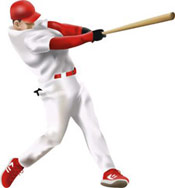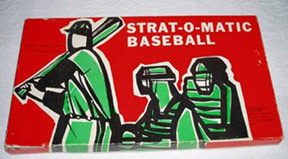He kept a diary—a friend, a boy we knew when we were young, all those years ago—and at the end of most entries he would assign himself a line from a baseball box score, defining each day as though it were part of some classic pennant race against . . . well, who knows? The general malevolence of the universe, maybe, or the daunting future and his own adolescent doubts, glaring down at him from the pitcher’s mound. June 2—Sue Mercer stopped to talk while I was sitting on the steps, so cute I couldn’t think of anything to say. Read a little, not much. Mowed the lawn. Shot hoops in the driveway; okay but inconsistent. Won at cards with my brothers. Today: 4 at bats, 1 hit, 1 walk, 1 RBI, 1 error. And then, at the end of the summer, Glen would add up how his days had gone, totaling his box scores to make a card for the season: 512 at-bats with a .291 average. 25 doubles, 5 triples, and 17 home runs. 57 walks and 48 strikeouts. 32 steals (he was always a fast kid) and a .972 fielding average (but a flawed fielder). Quick on the base paths, some power down the alleys, and he kept the ball in play. Too many fielding mistakes, but they weren’t from lack of trying, and his range to the ball made up for most of them. A good player, in other words, is how Glen quantified himself: not a star, exactly, but the kind of solid hitter any manager could use in his lineup. Several wins above replacement. If he wasn’t headed for the Hall of Fame, he wasn’t about to be sent down to the minors, either. He was in the game. But the card he made—that was the fun part, because it wasn’t just a bubblegum card: some lifeless piece of Topps or Fleet cardboard, good mostly for clothes-pinning to your bike so the spokes would rattle and roar as you rode along. Or for collecting, naturally, but that was the kind of thing old men like your friend’s dad did, getting angry every time he saw the neighborhood kids handling their cards because it lowered their value—and if he’d had the sense to keep his Phil Rizzuto card untouched in plastic, instead of pinning it to his own bike when he was a kid, it would be worth a thousand dollars now. Or more, he’d always add. Or more. No, the card Glen would make was a Strat-O-Matic card. Remember Strat-O-Matic? You’d see advertisements for the statistics-based board game in the back pages of comic books, the blurry newsprint of the Sporting News, and those annual baseball previews that seemed to sprout like flowers on the magazine racks early each spring. Maybe a friend had a Strat-O-Matic set, with its red box and the previous year’s Major League teams, each player with his own statistical card, and you’d go over to battle it out on the front porch. Or maybe you had your own set, and you’d sit up late to play by yourself—Game One of the Red Sox hosting the Reds in the 1975 World Series: Fenway Park spread out on the floor before you, under the light of a gooseneck lamp. Luis Tiant on the mound, and the hard-driven Pete Rose leads off with a fly ball to center, easily pulled in by Fred Lynn for the first out. The incomparable Joe Morgan follows with a single slapped to left, and the crowd groans as the all-star, all-time, all-everything catcher Johnny Bench steps into the batter’s box to try to drive him home. ################# What brought the cards to life was a roll of three dice, one white and two red. In the basic game, each card had three columns: three on the batter’s card and three on the pitcher’s card. If the white die came up 1, 2, or 3, you looked for the result in the corresponding column on the batter’s card; 4, 5, or 6, and you turned to the proper column on the pitcher’s card. Each column had 11 entries, labeled 2 through 12, and you used the sum of the red dice to find which of those entries to use—one of 216 possible chances for each at bat. The Strat-O-Matic game designers would start with the league average for any given year, and then adjust Joe Morgan’s batting card to give him the results that revealed his skill above an average batter’s. And Luis Tiant’s card to show his skill above an average pitcher’s. Of course, baseball offers more than 216 possibilities for any particular at-bat. What about a pulled hamstring, while the runner tries to stretch a single into a double? What about a balk, a hit-and-run, or a fielder’s choice? A pop-up hitting a pigeon in midair, for that matter? Besides, 216 possibilities equal chances only around 0.46 percent each—and baseball’s record-keeping allows much finer statistical divisions than that. So Strat-O-Matic added various ways to complicate the game: entries that would be outs against good fielders but hits against bad ones. Charts to look up the result of certain special situations. A few lines that would read something like TRIPLE 1–4, DOUBLE 5–20, with the result determined by a deck of small cards numbered 1 to 20, shuffled before the game. All in all, the setup was ingenious. It felt right, somehow, that basic 50-50 chance of the white die directing you to results based either on the batter’s skill or the pitcher’s. At its best, Strat-O-Matic offered a kind of small aesthetic perfection, walking the narrow line between accuracy and ease of play. The history of baseball board games is littered with homemade box sets, shipped from the garages of Strat-O-Matic players who thought they could re-create baseball even more accurately if only they invented a board game that used, say, 12 dice and 66 look-up charts! And so they could, but the result was always dull and too complicated to be worth the effort. The making of Glen’s card at the end of every summer required unlocking Strat-O-Matic’s secrets—and learning more math in the process than school ever taught. But once he’d calculated the frequency of each type of hit, the frequency of each type of out, there he was, card in hand, ready to slot himself into the outfield for the Red Sox and discover whether moving Yastrzemski to first base earlier in the Series would have made the difference. Or maybe he could have helped the Pirates derail the Reds in the National League championship. He could play anywhere—play, for that matter, in any era for which Strat-O-Matic sold historical sets. The 1924 Washington Senators, for instance: Now there was a great team, a fun team, but they had a hole in the outfield that the likes of Nemo Leibold, Wid Matthews, and Showboat Fisher couldn’t fill. Glen could, however: His card from the year he was 13 would provide exactly the extra-base power the Senators needed to help Joe Judge and young Goose Goslin back up the pitching of Walter Johnson. And what about Bing Miller, a weak link on Lefty Grove’s 1931 Philadelphia Athletics? Glen could swap him out with another of his own cards—the one from the year he was 12, for instance—and try to push the A’s past the Cardinals. Or he could see if, with his help, the 1945 Cubs could slip by the Tigers and break the Chicago team’s curse. He could play alongside Roger Maris and Mickey Mantle. Bat with Jimmie Foxx and Al Simmons. Join Duke Snider and Jackie Robinson. He could travel in time and play on any field of dreams. Or he could stand back and let the original players fight it out—lacing up their cleats to run and throw and hit, coming to life again in a way the past so rarely does for children. And that, in the end, may be the best thing Strat-O-Matic achieved. It brought the past into the present for its young players and kept that past alive. ################# That’s not to discount the ways the game introduced its young fanatics to probabilities, the easy first entry into statistics that comes from calculating dice rolls. We learned very quickly why the number 7 turns up once in every six throws of a pair of dice, 9 once in every nine throws, and 11 once in every eighteen. One of the striking things about The Numbers Game, Alan Schwarz’s wonderful 2004 history of baseball record-keeping, is how many of the past two generations of baseball’s mad number-crunchers got their start playing Strat-O-Matic and being drawn into its mathematics. Fantasy baseball was thought up by Strat-O-Matic player Daniel Okrent, and Electronic Arts’s popular baseball video game was invented by his fellow fan Trip Hawkins. All those innovative statistics baseball has gained over the past fifty years, from On Base Percentage to Wins Above Replacement—they sprang from seeds planted that winter day in 1961 when Strat-O-Matic first appeared. The board game may even have helped change the physical game it tried to model, although evidence for any direct influence is sketchy at best. Mickey Mantle is supposed to have complained in a radio interview that his Strat-O-Matic card had nothing but “homers and strikeouts,” but no one has a transcript of the interview, and anyway his card couldn’t hold a candle to the quintessential Strat-O-Matic arrangement of homers and strikeouts generated by Dave Kingman in 1973. In his 2005 book Strat-O-Matic Fanatics: The Unlikely Success Story of a Game That Became an American Passion, the journalist Glenn Guzzo enthusiastically pours out everything he could discover about the game’s impact, and yet it all proves sadly slight and circumstantial. Some Hollywood types—Tim Robbins, for instance, and Spike Lee—have said they loved Strat-O-Matic (and the game appears in Lee’s 1994 film Crooklyn). The broadcaster Bob Costas occasionally mentions that he used to play, as do other sportswriters when indulging in nostalgic recollections of their baseball-loving childhoods. In the Major Leagues, Lenny Dykstra and Keith Hernández would pull out the cards and dice on long road trips. Avid Strat-O-Matic player Doug Glanville roars with laughter as he tells the story of fans jeering his Phillies teammate Gregg Jefferies with “You’re a 5, Jefferies, you’re a 5” (the worst Strat-O-Matic rating for a fielder). More credible evidence of the game’s impact comes in the form of occasional bits of praise from baseball executives. In 2002, when he was named to head up the Red Sox—28 years old, the youngest general manager in baseball history—Theo Epstein was often derided in the Boston press for treating the team’s players like “a set of Strat-O-Matic cards,” keeping or dealing them to other teams based on their statistics. (Those complaints quickly disappeared when, in 2004, the Red Sox won their first World Series in eighty-six years.) Glenn Hoffman, the coach who briefly managed the Dodgers in 1998, reports having played Strat-O-Matic, as do others in the crop of game changing general managers who relied on the power of modern statistics, from Oakland’s Billy Beane (the hero of Michael Lewis’s Moneyball) to the Orioles’ baseball blueblood, Andy MacPhail. Even so, there’s no suggestion that baseball’s executives actually played Strat-O-Matic while running their teams, much less that they used it to make real-life decisions. Despite its enthusiasts’ claims, Strat-O-Matic’s influence on Major League diamonds is indirect, at best, flowing through the interest in statistical analysis that the board game awakened. But awaken that interest the game did—and something more as well. Deep in the psyche of boys lies a hunger for order and a world that makes sense, an intelligible universe of rankings and meaning. Deep in the psyche of girls too, maybe, although girls were alien creatures, at best, and we didn’t know any who played Strat-O-Matic when we were young. Besides, the inner lives of adolescent males hold other things—monsters and nightmares—that need to be starved even while the blessèd rage for order is fed on numbers. Who knows what evil lurks in the hearts of boys? But some of it, surely, wasted away from inattention during the hours spent deciding the best way to set the batting lineup of the 1961 Tigers. The tumbling dice did reveal plenty of randomness, a disorder that populated the game with strange outliers and statistical freaks. Given enough chances, Casey Stengel’s comically inept 1962 Mets would win—must win—a game against the Murderers’ Row of Babe Ruth’s 1927 Yankees. With a different roll of the dice, the fan Steve Bartman stays home with the flu and Moisés Alou makes that outfield catch in 2003, letting the Cubs escape with a victory. Managed with a clearer eye (as Theo Epstein understood), the Red Sox could have won—in Strat-O-Matic did win—a World Series well before 2004. And yet, in the end, over a long-enough set of games, the play would work out pretty much as you would expect from the players’ statistics and the teams’ strengths. The Cincinnati Reds were a powerhouse in the mid-1970s, and only the most inept play was going to hurt them much. The Seattle Mariners were very lucky to win 116 games in 2001, in exactly the way you knew they were while watching them. Over thousands of dice rolls, Mantle’s 1960 Yankees would usually beat Mazeroski’s Pirates, Hank Aaron would typically hit around 44 home runs in a season, and Dennis Eckersley would almost never hang a 1988 slider to Kirk Gibson. The world Strat-O-Matic created was an orderly one, and meaningful—and it gave life to the cold statistics of current players, first learned from bubblegum cards. Maybe that combination of stern order and wild exception is what made Strat-O-Matic so fun, so fitting, to play. Curious to think of all the game did. It introduced its young players to decision-making and gauging the odds, laying the groundwork for later, more portentous decisions. It occupied hours that might otherwise have been filled with things less playful and innocuous. It brought previous generations back in view, re-creating the past and valorizing the lives of old players, the giant race before the flood. Unlike the video games that began to spread like poison ivy in the 1990s, it spurred the imagination and encouraged exactly the fascinations of boys that prove socially productive—even while it displaced the fascinations that, in any culture, make young men a threat to social order. It’s not difficult to realize, in retrospect, that Strat-O-Matic was a time-filler, a device for having fun that also taught a little about baseball. Along the way, however, it also proved a doorway to the inner game of baseball and, through baseball, to the game of life. A small but useful tool of civilization. Hard to say, really, what more you could ask of a board game. ################# The Reds’ Don Gullett toes the rubber in the bottom of the first, and the Red Sox’s Dwight Evans steps into the batter’s box—3 on the white die, 9 on the red dice, for a single. Denny Doyle lays down a bunt, but Evans is out at second, and Carl Yastrzemski strides to the plate—white die 2, red dice 9, for a walk. Carlton Fisk digs in. White 4, red 10, a strikeout. Fred Lynn’s turn—white 5, red 5, and Gullet’s pitching card shows Lynn sending a slow roller to Joe Morgan at second. Three outs and the inning’s over. ################# We played a lot of board games when we were young: Monopoly and Life and Battleship and silly contests we’d invent ourselves involving Yahtzee dice and football scores. A lot of card games, as well. Mostly gin rummy, but then there was that summer the collective mind of the neighborhood kids decided we needed to learn bridge, and—in memory, at least—July and August were consumed in rounds of bidding. We had pickup basketball games in the driveway, and books devoured in a gulp, and bicycles ridden to friends’ houses. Whiffle Ball when we couldn’t field enough players for a real game, and kick-the-can as an excuse to hide alongside the girls, and afternoons to rock away in a sleepy hammock. Baseball, as well, down at the local park with the rusted backstop and dirt bases worn in the grass, home base defined with a paper plate. The puddle of water in the batter’s box from the morning sprinklers, and the taste of salt on your lip as you trotted out to centerfield. Foul balls that deflected off the trees and into the street, chased down before they disappeared through the grill in the gutter. The angry family, when a long fly ball landed on the blanket they’d spread for a picnic. Playing one last inning, even though it had grown too dark to see, until the third-baseman’s parents sent his little sister down to call her brother home, and the game ended in a tie. And then at night you could hear the crickets through the open window. Moths fluttering at the screen, the evening’s descending cool after the afternoon heat. Glen would sit at his desk and mark down how he’d done in the baseball game that day—how we’d all done. The summers were long, like an extra-inning game, with endless hours to fill. Sundial days, they all seem now, looking back. Days lived in the cycle of the sun unmeasured by clocks, and we seemed to have time enough for anything—time enough to have time, if that makes any sense. Time enough, anyway, to play entire seasons of Strat-O-Matic and soak in their lessons. The dice clicking on the inside lid of the game’s cardboard box offered, in their way, an escape into order from the middle school chaos of hormones and emotional brutality. A 10- or 11-year-old boy could run around outside only so much. And when the few television channels had been exhausted, Strat-O-Matic was there to fit in with the established summer ritual: Get up when the sun warms your room, open a box of cereal, read the box scores in the newspaper. Without a Major League team nearby, and not all that many professional games on the radio, Strat-O-Matic connected us to the players and their statistics—giving life to the shadowy profiles of past and present greats and the myths that surrounded them. ################# George Foster, top of the second inning for Cincinnati—6 on the white die, 5 on the red dice, and Tiant’s pitching card gives Foster a single to center. Dave Concepción slips off the batting donut and steps to the plate. White 1, red 4: HOME RUN 1, DOUBLE 2–20, the line on the card reads. The split deck comes up a lucky 1, and Concepción rounds the bases with a home run. The Reds lead 2–0. ################# It was out on Long Island in 1948, in the town of Great Neck, that Hal Richman sat down and rolled a set of dice 5,000 times, recording every outcome—just to make sure he had calculated the odds correctly. He was only 11 years old, which perhaps explains why he didn’t trust his math, but once the dice confirmed his calculations, he designed a baseball board game to take advantage of his newfound probabilities. He adjusted the game after trying it out with his friends at summer camp, adjusted it again after playing it with his fellow math students at Bucknell University, and finally in 1961 he thought he was ready to have some copies printed and start selling the game. Disaster was pretty much the result. The game still seemed unpolished in design, and the two-color printing, the best Richman could afford, was sloppy and off-register. Even the small-text advertisement he purchased in Sports Illustrated cost more than he could really pay for. The game made no inroads into the market of baseball board games dominated by APBA (which had begun production in 1951) and Cadaco’s All-Star Baseball (a 1941 game with the advantage of being distributed through toy stores). Add to all that the fact that the name—Strat-O-Matic, an odd attempt to work a hint of the word statistics into the 1950s buzzwords stratosphere and automatic—felt dated even by the early 1960s. If its creator couldn’t see how amateurish and hokey the hyphens around that capital O seemed, potential buyers could. The game barely sold in the dozens and left the recent college grad $2,500 in debt. Richman’s response was to double down. In 1963, he redesigned the game into the form it still has, borrowed $5,000 from his father (on condition that if he didn’t succeed this time, he would join his father’s insurance firm), and bought a better advertisement in the cheaper pages of the Sporting News. Fifty years later, the game is still going: Total sales over the years, the cautious Richman reluctantly admits, are in the millions. (In 2011, Strat-O-Matic issued a special anniversary edition, reprinting that first version of the game. It flopped, too.) Always run on a low advertising budget, Strat-O-Matic spread mostly by word of mouth and whatever boys it could lure with text-heavy magazine ads. Its greatest exposure came when NBC’s Today Show—in protest over the postponement of the All-Star Game because of the 1981 players’ strike—broadcast a Strat-O-Matic game played with cards for all-stars from the previous year. (Strat-O-Matic fan Bryant Gumbel reportedly came up with the idea, and he acted as the play-by-play announcer, calling the game in breathless segments through the course of the show.) In subsequent years, Richman and his eight Great Neck employees settled into a small but reasonably profitable niche in the game market, ahead of such competitors as APBA, Statis, and the set of baseball games distributed by Avalon Hill. Their research into the Negro Leagues produced a successful set of player cards, and although their attempts to move into the computer-game markets have not been particularly well received, the historical card sets the company has produced since the 1970s—classic teams from the 1927 Yankees to the 1954 Giants, the 1906 Cubs to the 1957 Braves; notorious teams from the 1919 Black Sox to the 1962 Mets, for that matter—have always sold well. The rise of fantasy baseball and other group games, together with the easy calculations that computers allow (sharply shifting the old line that Strat-O-Matic walked between accuracy and ease of play), are mortal threats to the board game, and too much of its current play seems to be fueled by baby-boomer nostalgia. Still, the company survives, much as its 75-year-old founder does. And every year a few hundred diehard fans show up at the company’s offices in Great Neck on the last Friday in January—the day, by fifty-year-old tradition, the new season’s cards go on sale. #################
Bottom of the sixth, the Reds
2 and the Red Sox 0. Rico Petrocelli steps in. White 3, red 7: a
walk. Rick Burleson follows—white 3, red 5: a single, with
Petrocelli moved along to second. Gullet stares down Cecil
Cooper. White 5, red 8: a pop-out to first base. Tiant spits
tobacco and waddles to the plate. White 4, red 5: TRIPLE 1–4,
DOUBLE 5–20, the corresponding entry reads, and the card from
the split deck is a 6. A double for the Red Sox’s pitcher, and
Petrocelli scores. Burleson tries for home. His running speed is
listed as 1 to 12, and the next split card is a 7. Burleson
crosses the plate, tying the game ################# We tend to over-interpret and overvalue the things that fascinated us when we were children: the books, the toys, the music, the games. Because memory makes them shine so brightly, we imagine they still possess their own, interior light. They don’t, more often than not. Oh, Roger Kahn’s account of the 1950s Dodgers, The Boys of Summer, really is a marvelous book, worth rereading, but that pet chicken in The Kid Who Batted 1.000 can only make you cringe, if you’re foolish enough to take a look at the book again in adulthood. Robert Coover’s The Universal Baseball Association, Inc., J. Henry Waugh, Prop.—a tragicomic novel about a man who invents a dice baseball game much like Strat-O-Matic, only to find himself drawn into life inside the game—was a great adolescent read, but even at the time you could feel it dissipating the innocence of game play, the postmodern metanarrative of the story a kind of guilty pleasure. Too great an awareness of what we do weakens our ability to do it; the boy who rises to consciousness of the fact that he’s being taught a lesson gradually ceases to learn that lesson. And somewhere along the line, what seems to slip away is time—the time to have time for losing yourself in such things as baseball seasons played out with dice rolls. The world intrudes, the boy grows, and the games prove less enthralling. Still, the lessons of Strat-O-Matic were real and vital, in their day. A realization of the interplay of order and randomness, for instance. A grasp of the sheer reality of the past, the truth that others lived before us. The civilizing of boys by appealing to their impulses to forget themselves in the mathematics of the world and the inner secrets of a game like baseball. ################# Score tied 2–2, bottom of the ninth, 2 out, no one on base. Don Gullet still stares from the mound as Jim Rice, his wrist heavily taped, emerges from the dugout to pinch-hit for Cooper. Maybe he can give the team one good swing. White 1, red 7—a home run, and the Red Sox take the Series opener 3–2. ################# Late at night in those long summers, Glen would sit—each of us would sit—alone on the floor of a darkened room with a single light focused down on the finished game. Even afterward, in bed, the numbers and images swirled in our minds. And the only real questions were how the Series would come out, and whether there was time for one more Strat-O-Matic game before tiredness overtook us and carried us down to sleep.
Alan
Davison is Professor of Spanish
at Westminster College in Salt Lake City and the author of a
daily webcomic at
http://blurtso.com.
♦ RETURN TO NEWSLETTER MAIN PAGE ex-MLB player with Royals, Cubs and Mets.♦ INTERVIEW with JEFF MONTGOMERY, ex-MLB player with the Royals.
♦
SOM BASEBALL WORLD NEWS,
a new page to share interesting news related to
♦
ARTICLE with HANK SMITH,
former Star Tournaments Commissioner and Ambassador ♦ EARLY SOM CONVENTIONS COLUMN with WOLFMAN SHAPIRO -- editor of "The Ultimate Strat Newsletter" and 2012 CBA Champion, Wolfman takes us back in this article to the ninth national Strat-o-matic Convention in 1980, held in Evanston, IL, at Northwestern University, as the Wolfman and his buddies organize their seventh and final convention via their Chicagoland SOM Club. Unfortunately, due to personal changes in the Wolfman's life at that time, a report of what took place at the convention was not sent to the SOM review. This article will transition us to other types of tournaments that have been offered after 1980 and to honor Hank Smith. Also we hope this column will inspire our readers to help us create a SOM On-line Baseball Convention in the near future. ♦ COMMISSIONER's CORNER with MARC WASSERMAN -- commissioner of the Cyber Baseball Association (CBA) continues his column about what it is like to be a League Commissioner. In this article, he turns his focus to discuss how the start of the CBA began with its Canadian roots and once again is being strongly influence by our Canadian members.♦ RECOMMEND ON-LINE SOM RESOURCES -- On-line Strat-o-matic and Baseball related websites that offer amazing information, special tools and products to improve your game play that we strongly recommend. In most cases, we have had personal contact with these sources who agree with the principle to work together and help promote each other. ♦ BOOK REVIEW with WOLFMAN SHAPIRO Wolfman takes a peek at the " Baseball Prospectus 2014 Guide" created by Baseball Prospectus and over 20 contributing writers. This guide features predictions for over 2,100 players who will or could be a part of the upcoming 2014 season. CEO, Joe Hamhari, helped us to get this book. He is an avid SOM baseball gamer who we interviewed in the August 2013 issue of the newsletter.♦ BOOKS TO DIE FOR and Become a BASEBALL GURU -- This page is specifically about special books we are finding that either will expand your insights about the game of Baseball, help you in the creation of your current league teams or with your replays and learn more about the Strat-o-matic Base Game and Game Company's history. We have a special arrangement with Acta Sports, who is a publisher of a number of great baseball books (including Bill James Handbooks) to offer for our members a 10% discount. We will continue to add more books to this page in the future as we uncover other gems our members should know about.
Wolfman Shapiro
To Sign Up and Become a Member of this Newsletter
To
Learn more about the SOM On-line Convention attempted
|





